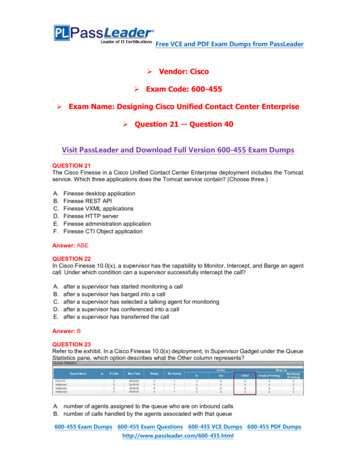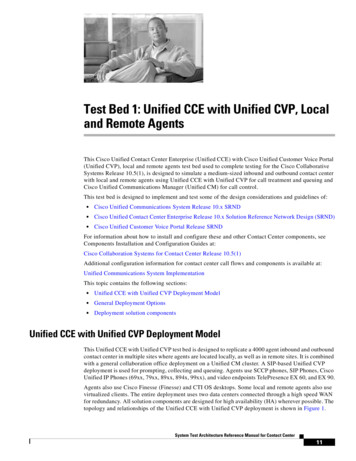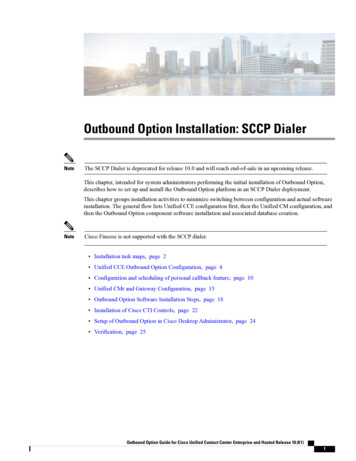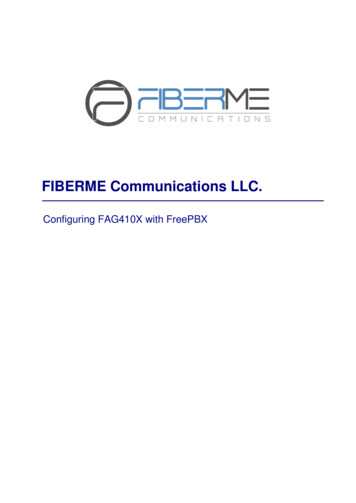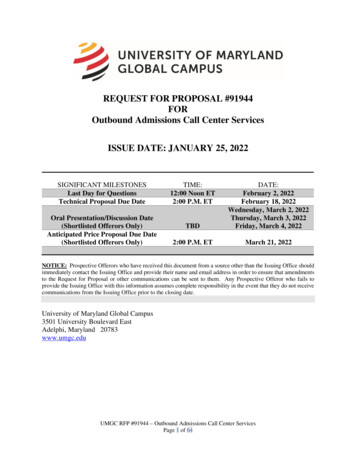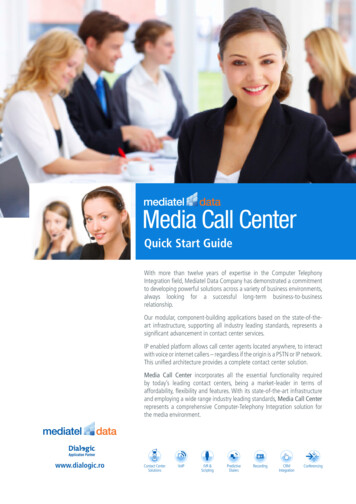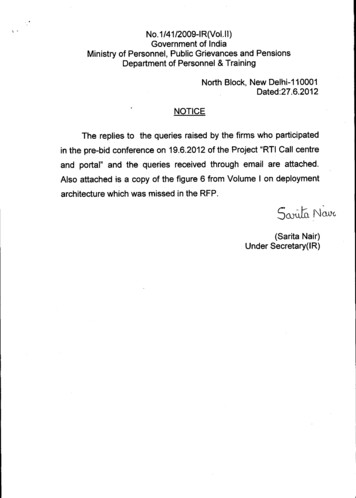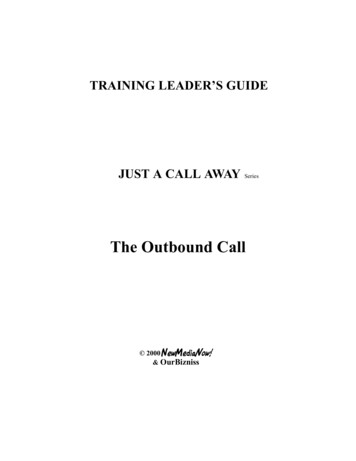
Transcription
TRAINING LEADER’S GUIDEJUST A CALL AWAY SeriesThe Outbound Call 2000 New Media Now!& OurBizniss
COPYRIGHT WAIVERIn order to provide you with cost-effective training,& OurBizniss Productions have waived copyright on this trainer’s manual.This waiver, however, is limited to organizations that have purchased thevideo based training program The Outbound Call.You may make as many duplicates of the material within as you like.However, these duplicates may not be resold. They are only to be used inconjunction with this program.Consultants training on a freelance basis are not permitted to sell copies ofthis material to participants. However, they can duplicate whatever portionsare necessary, provided these are free of charge.COPYRIGHT RESTRICTIONSThe video JUST A CALL AWAY – The Outbound Call is protected bycopyright. No unauthorized viewing of this program is allowed. We mustask that you not copy, edit, add to, or reproduce the program in any waywithout the express prior written permission of& Our Bizniss Productions.We price our videos so that they are easily affordable and can be widelyused. Their purchase price is our only source of income and enables us tomake further videos to add to your training resources.Legal action will be taken if any conditions of purchase are breached.1–DJUST A CALL AWAY – The Outbound Call
CONTENTSPAGEForeword3DPreparation3DSynopsis4DIcon Key4DCourse Structure and Running Time5DWelcome6DObjectives and Agenda6DIntroduction7DThe Video8DThe Discussion9DActivity 1 — Call Objectives12DActivity 2 — Call Guide12DActivity 3 — The Gatekeeper13DActivity 4 — Products and Benefits14DActivity 5 — True or False?15DSummary and Debrief16DParticipant Handout MastersOverhead MastersJUST A CALL AWAY – The Outbound Call2–D
FOREWARDThis program is designed as a half-day training session on handling theoutbound call.Just as the organizations that use this program are wide and varied, soare the desired outcomes of the participants attending. As a result, wehave tried to make The Outbound Call as generic and flexible aspossible.This manual will provide you with some background notes, along withpractical activities and suggested running times. Feel free to add to oradapt the structure of this training session to suit your needs.You do not need to complete all exercises provided unless they suit thespecific requirements of your organization. Of course, the agenda isonly a guide. The time spent on each activity is entirely dependent onthe objectives of the trainer/facilitator and the progression rate ofparticipants.PREPARATIONIn order to maximize the benefits of this training session, werecommend that the trainers/facilitators familiarize themselves with thetopic at hand. You should be comfortable with the material in both themanual and the video.You have been supplied with master copies of overheadtransparencies and participant handouts. Make sure that sufficientcopies of each have been prepared prior to the training session.In the training room, you will need the following:- Overhead projector- Monitor and VCR player- Whiteboard with markers and eraser- Note paper and pens or pencils for participants3–DJUST A CALL AWAY – The Outbound Call
SYNOPSISJUST A CALL AWAY – The Outbound CallIsaac Jones works in a busy insurance company call center. His job isto make appointments for sales representatives to visit potentialcustomers. His first call of the day is to a home business, The FoxfieldRacing Stables. It turns out to be a disaster. He is strung along by9-year-old Danielle, who has him believing the loss of her guinea pigwas really the theft of a million dollar racehorse.After learning some basic techniques about setting objectives,developing a call guide, qualifying the customer, and handling theGatekeeper, the confusion is averted. He also learns tips on when toleave messages and the importance of measuring his success.After several unproductive calls, Isaac encounters Franco, who is in themidst of moving his office and has an angry visitor at the door. ForIsaac this is simply bad luck — he couldn’t have picked a worse time totry to share the benefits of his company’s services. He initiallyresponds emotionally, winding up his prospect into an emotionalfrenzy. Once again, after mastering some simple techniques, hemaintains a professional attitude and learns to handle the calleffectively.However, these unproductive calls leave Isaac with a bout of callreluctance that could seriously affect his work. By talking to acolleague and remembering his successes, he is soon back on track andready to make his “call backs.”The story concludes with a positive response from The Foxfield RacingStables and, surprisingly, another introduction to the notorious Franco.ICON KEYReadOverheadAsk and DiscussJUST A CALL AWAY – The Outbound CallHandoutVideo4–D
COURSE STRUCTURE AND RUNNING TIMEThis course has been designed to run as a half-day trainingsession. If you do all of the coursework within the allocatedrunning time, your training session should run for approximately4 hours.COURSEWORKRUNNING TIMEWelcome15 minutesObjectives and Agenda10 minutesIntroduction15 minutesThe Video35 minutesBreak10 minutesThe Discussion30 minutesActivity 1 — Call Objectives10 minutesActivity 2 — Call Guide15 minutesActivity 3 — The Gatekeeper10 minutesActivity 4 — Products and Benefits15 minutesActivity 5 — True or False?15 minutesSummary and Debrief50 minutes5–DJUST A CALL AWAY – The Outbound Call
WELCOMETime:15 minutesTrainer’s Instructions: Welcome all participants to the The Outbound Call trainingsession. Introduce yourself and tell the group something about yourtraining background. Explain how the training session is to be structured, how longit will run, when the video will be shown, when breaks will betaken, what refreshments are available, and where the phoneand restrooms are.OBJECTIVES AND AGENDATime:10 minutesTrainer’s Instructions: Discuss the objectives and agenda of this training course withthe group. Whether you’re calling business to business orbusiness to consumer, this training course will provide youwith some valuable tips to help build relationships withcustomers.After completing the training session on The OutboundCall, you will understand the following: Setting primary and secondary objectives Measuring success The basics of creating a call guide for the first15 seconds Handling the Gatekeeper Handling the unappreciative prospect Dealing with call reluctance Building customer relationships Signing off with serviceJUST A CALL AWAY – The Outbound Call6–D
INTRODUCTIONTime:15 minutesTrainer’s Instructions: Using your own research and the brief notes provided below,give participants a brief overview of the importance of theoutbound call to their own organization. Invite questions and discussion from the group as you go.The outbound call is a way to increase customer service. Itcan be a way of canvassing new customers, informingcustomers of new products, or simply following up salesfor feedback on how your organization can better servicetheir needs. In America, the outbound call generates 435billion worth of revenue.Making the outbound call is all about buildingrelationships. When a prospect has a need for a particularproduct or service, he or she will gladly accept the call andlisten to a pitch from an outbound caller. If they don’t havea need, they will see the outbound caller as an annoyinginterruption to their busy lives.The aim of a successful call is to:1. Initially establish a rapport2. Engage the prospect in a needs analysis3. Offer a solution4. Close the sale or complete the objective of the call7–DJUST A CALL AWAY – The Outbound Call
THE VIDEOTime:Video 15 minutesDiscussion 20 minutesTrainer’s Instructions: Play the video The Outbound Call.Lead a short discussion around the video. Have you ever had any experiences like those of Isaac(either as a customer or as a call center agent)? What sort of personality traits did Isaac display evenin the very beginning?Answer: polite, enthusiastic, friendly Do you think that being polite, enthusiastic, andfriendly was enough for Isaac to develop a rapportwith his first caller? How do you feel about the way Isaac initiallyrepresented his intentions?JUST A CALL AWAY – The Outbound Call8–D
THE DISCUSSIONTime:30 minutesTrainer’s Instructions: Using the overheads and your own notes, continue to lead thediscussion, encouraging participants to ask questions as yougo.The outbound caller will always have at least twoobjectives:1. A primary objective — that is, what he or she hopesto achieve from the call.2. A secondary objective — which is to leave a positiveimpression of your organization regardless of whetherthe prospect is interested in your product or service.PRIMARY OBJECTIVEwhat you hope to achieve from the callSECONDARY OBJECTIVEleave a positive impression of your organizationIn order to measure your success, you must focus on yourobjectives and record your progress when you completeyour call. It sounds very simple, but it’s the only way ofaccurately knowing how you are performing.There are three rules for setting your objectives. You mustwrite them down. They must be realistic, and they mustbe measurable.RULES FOR SETTING OBJECTIVESa. You must write them down.b. They must be realistic.c. They must be measurable.When you have done that, you must focus on them beforeyou make the call.9–DJUST A CALL AWAY – The Outbound Call
As you saw in Isaac’s conversation with Danielle aboutFluffy, the first 15 seconds of a call are crucial. Youneed to explain who you are, where you’re from, and whatyou want. Find out if you’re speaking to the right personand, if you are, peak their interest.YOUR CALL GUIDEWho you areWhere you are fromWhat you wantAre you speaking to the right person?Peak their interestFriendly, natural deliveryAvoid reading your guideIt’s a tough ask for 15 seconds, but it can be done.Remember to make your delivery friendly and natural —avoid reading your call guide whenever possible.When you encounter those people we call the“Gatekeeper,” bear in mind that although that person isnot your customer, they know who is. So be polite and respectful and remember their name.Try not to leave messages with the Gatekeeper. Instead,find out a convenient time to call back.RULES FOR THE GATEKEEPERBe polite and respectfulRemember their nameTry not to leave messagesFind out a convenient time to call backNo one is sitting around waiting for you to call them andoffer a product, service, or solution to a problem that theydon’t know they have. So sometimes your reception maybe less than friendly.JUST A CALL AWAY – The Outbound Call10–D
When an initial response is curt, ask permission to goforward. If it is denied, remain polite, apologize, andthank them for their time.RULES FOR THE UNAPPRECIATIVE PROSPECTAsk permission to go forwardRemain politeApologizeThank them for their timeAfter a series of calls where you don’t achieve yourobjectives, it’s quite common to face call reluctance.You would gladly do anything but pick up the phone anddial or hit the button for the next customer. This isnormal. It happens when you take the rejectionpersonally. Whatever happens, you cannot take rejectionto heart — even the rudest customers are not rejectingyou personally.Fear of rejection is real. Recognize it and let it go. Talkto a colleague about it, and remember to be supportive tocolleagues when they talk to you. Remind yourself ofprevious successes, and reward yourself for reachingsmaller goals.CALL RELUCTANCEDon't take rejection personallyRecognize the fear and let it goTalk to a colleagueRemind yourself of previous successesReward yourself for reaching smaller goalsIn the body of your call, ask pertinent questions, listencarefully, and focus on the problems you solve, not theproduct you sell.Sign off with service!And finally, always sign off with service, which meansa genuine offer of continuing assistance from yourselfand your organization.11–DJUST A CALL AWAY – The Outbound Call
ACTIVITY 1:CALL OBJECTIVESTime:10 minutesTrainer’s Instructions: Divide participants into groups of six to eight and ask them tolist primary and secondary objectives for a specific outboundcall. Either use the example the class is/will be working withor use the example from the video. For example, what areIsaac’s primary and secondary objectives? Go through the responses on the whiteboard and discusswhether they can be characterized by being written, realistic,and measurable.ACTIVITY 2:CALL GUIDETime:15 minutesTrainer’s Instructions: Divide participants into groups of six to eight and ask them tolist five important things to include in a call guide. Go through the responses on the whiteboard and discuss whythey are important.Suggestions: Who you are Where you’re from What you want Are you talking to the right person? Peak their interest They are important because you must HONESTLYREPRESENT YOUR INTENTIONSJUST A CALL AWAY – The Outbound Call12–D
ACTIVITY 3:THE GATEKEEPERTime:10 minutesTrainer’s Instructions: Divide participants into groups of six to eight and ask themto list the do’s and don’ts for handing the Gatekeeper. Go through the responses on the whiteboard and discusswhy they are important.DosRemember, the Gatekeeper may not be your customer,but they know who is the customer.Be polite and friendly.Honestly represent your intentions.Remember their name.Find out information about who you need to speak to.Find out a convenient time to call back.Don’tsDon't be rude.Don’t be dismissive.Don’t leave messages.In the case of children or vulnerable individuals, don’tever be misleading or manipulative.13–DJUST A CALL AWAY – The Outbound Call
ACTIVITY 4:PRODUCTS AND BENEFITSTime:15 minutesTrainer’s Instructions: Ask participants to complete The Product Verses the Problemhandout. Go through the responses on the whiteboard, and discuss thedifferences between products, features, and benefits.The Product Versus the Problem Facilitator’s CopyProduct or ServiceProblem it could solve for thecustomerDipsy Doodle DoggyWashIt won’t be you chasing Roveraround the yard, dragging himtowards the bucket and soap, andpulling out those nasty, prickly burrsthat he gets between his paws.TiresThey will address your concernsabout the safety of yourself or yourfamily on the road.Pre-paid CremationYour family will not have the worryof deciding what you might havewanted.Frozen PizzaYou will have more time to watchtelevision instead of sweating over ahot stove.Net BankingYou can do your banking at midnightif you didn’t get time to make thoseimportant payments during the day.JUST A CALL AWAY – The Outbound Call14–D
ACTIVITY 5:TRUE OR FALSE?Time:15 minutesTrainer’s Instructions: Ask participants to complete the True or False? handout.Go through the handout and discuss the answers. Addressany questions the group may have.True or False? Facilitator’s CopyStatementTrue/FalseCall reluctance could never happen to me.FalseWhen you’re feeling reluctant to make calls, keep it Falseto yourself. It will only bring everyone else down ifyou share your concerns.Remembering your successes will boost yourconfidence and help alleviate call reluctance.TrueIf a customer is rude, obnoxious, and angry that you Truehave called them, they are not rejecting you.Rather, they are rejecting the product or service youare offering.15–DAsk permission to go forward when you receive acurt initial response.TrueIf the caller is upset about your calling, hang upwithout saying anything.FalseAsk probing and clarifying questions to determinethe customer’s needs.TrueOffer customers solutions to their problems ratherthan trying to sell them a product or services.TrueSign off the call by thanking the customer for theirtime.FalseJUST A CALL AWAY – The Outbound Call
SUMMARY AND DEBRIEFTime:50 minutesTrainer’s Instructions: Play the video again. Go through some of the training points highlighted inthe video using the overheads. Ask for and answer any questions that participantsmay have. Let participants know if and when any follow-uptraining is to be conducted. Give participants a copy of the Summary Sheethandout.JUST A CALL AWAY – The Outbound Call16–D
PARTICIPANT HANDOUTMASTERS
THE PRODUCT VERSUS THE PROBLEMProduct or ServiceDipsy Doodle Doggy WashTiresPre-paid CremationFrozen PizzaNet BankingProblem it could solve for the customer
TRUE OR FALSE?Decide whether the following statements are true or false.StatementCall reluctance could never happen to me.When you’re feeling reluctant to make calls, keep it to yourself. It willonly bring everyone else down if you share your concerns.Remembering your successes will boost your confidence and helpalleviate call reluctance.If a customer is rude, obnoxious, and angry that you have called them,they are not rejecting you. Rather, they are rejecting the product orservice you are offering.Ask permission to go forward when you receive a curt initial response.If the caller is upset about your calling, hang up without saying anything.Ask probing and clarifying questions to determine the customer’s needs.Offer customers solutions to their problems rather than trying to sellthem a product or services.Sign off the call by thanking the customer for their time.True/False
SUMMARY SHEETIn order to measure your success, you must focus on your objectives andrecord your progress when you complete your call.The first 15 seconds of a call are crucial. You need to explain who you are,where you’re from, and what you want. Find out if you’re speaking to theright person and, if you are, peak their interest.Remember to make your delivery friendly and natural. Avoid reading yourcall guide whenever possible.Bear in mind that although the Gatekeeper is not your customer, they knowwho is. So, be polite and respectful, and remember their name.Try not to leave messages with the Gatekeeper. Instead, find out a convenienttime to call back.Don't take rejection to heart. Even the rudest customers are not rejecting youpersonally.When an initial response is curt, ask permission to go forward. If it is denied,remain polite, apologize, and thank them for their time.Fear of rejection is real. When you are suffering call rejection, recognize thefear and let it go. Remember, the customers are not rejecting you personally,only the product or service you are offering. Remind yourself of previoussuccesses, and reward yourself for reaching smaller goals.In the body of your call, ask pertinent questions, listen carefully, and focus onthe problems you solve, not the product you sell.And finally, always sign off with service — an offer of continuing help andassistance from your organization.
NOTES:
OVERHEADMASTERS
OBJECTIVES AND AGENDAAfter completing this training course, you willunderstand: Setting primary and secondary objectives Measuring success Creating a call guide for the first 15 seconds Handling the Gatekeeper Handling the unappreciative prospect Dealing with call reluctance Building customer relationships Signing off with service
The aim of a successful call is to: Initially establish a rapport Engage the prospect in a needsanalysis Offer a solution Close the sale or complete theobjective of the call
PRIMARY OBJECTIVEwhat you hope to achievefrom the callSECONDARY OBJECTIVEleave a positive impressionof your organization
RULES FOR SETTING OBJECTIVES You must write them down. They must be realistic. They must be measurable.
YOUR CALL GUIDE Who you are Where you are from What you want Are you speaking to the right person? Peak their interest Friendly, natural delivery Avoid reading your guide
RULES FOR THE GATEKEEPER Be polite and respectful Remember their name Try not to leave messages Find out a convenient time tocall back
RULES FOR THEUNAPPRECIATIVE PROSPECT Ask permission to goforward Remain polite Apologize Thank them for their time
CALL RELUCTANCE Don’t take rejection personally Recognize the fear — let it go Talk to a colleague Remind yourself of previoussuccesses Reward yourself for reachingsmaller goals
Sign off with service!
NOTES:
CONTENTS PAGE Synopsis Foreword 3D Preparation 3D 4D Icon Key 4D Course Structure and Running Time 5D Welcome 6D Objectives and Agenda 6D Introduction 7D The Video 8D The Discussion 9D Activity 1 — Call Objectives 12D Activity 2 — Call Guide 12D Activity 3 — The Gatekeeper 13D Activity 4 — Products and Benefits 14D Activity 5 — True or False?



